My weekend trips to our relatives in Macabebe, Pampanga always meant one thing: my Tita Vangie's Chicken Asado.
The moment you'd walk into her humble kitchen, the aroma of chicken braising in its citrus-tomato sauce would instantly make your mouth water. I still remember how she'd lovingly share her secret - the liver spread that transforms the dish from good to extraordinary.
After years of watching her cook and countless attempts to recreate her recipe, I finally mastered this Kapampangan treasure.
Now every time I make this Chicken Asado, my kids have the same reaction I had in Tita Vangie's kitchen. They hover around the stove, impatiently waiting for the tender chicken and that rich, tangy sauce.
This family chicken asado recipe has been my go-to dish for both busy weeknights and special occasions, and I'm thrilled to share it with you today.
Jump to:
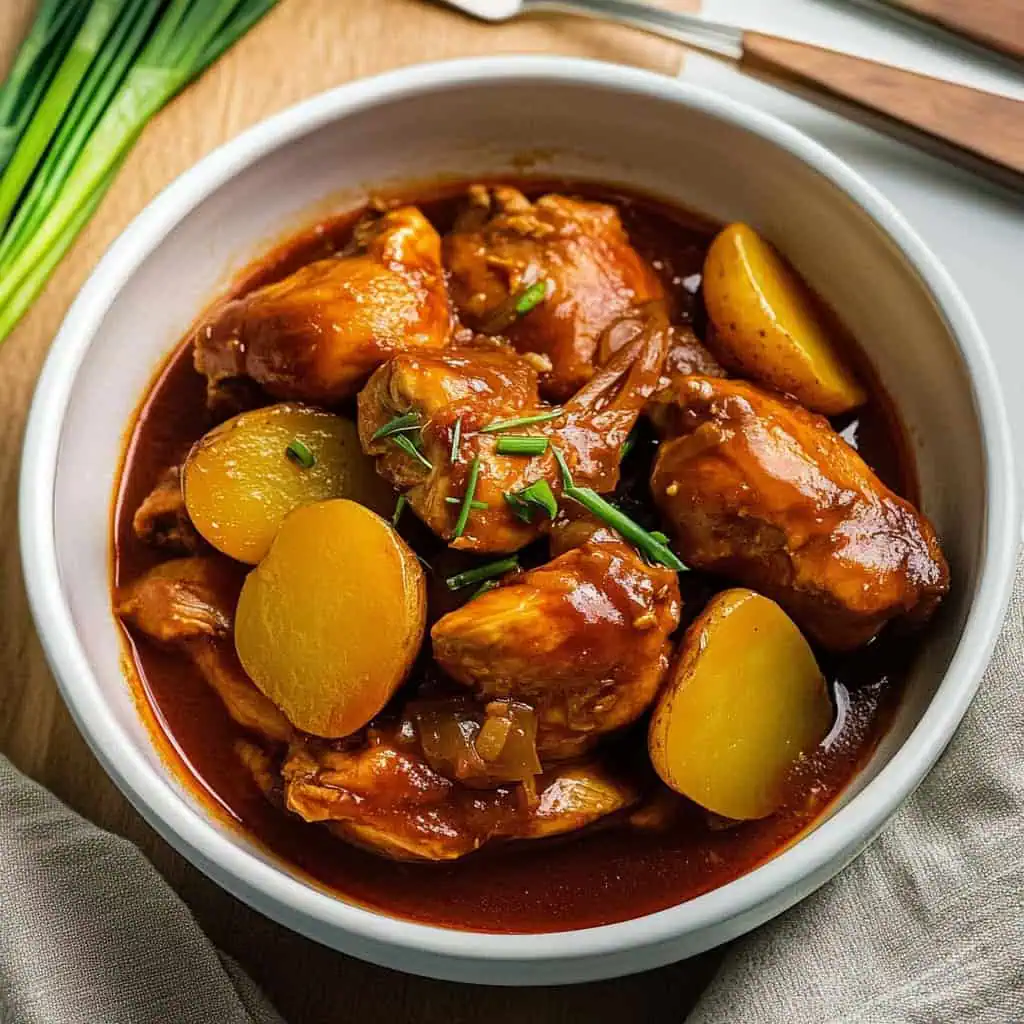
Why You'll Love This Recipe
- Perfect balance of tangy and savory flavors
- One-pan cooking for easy cleanup
- Budget-friendly family meal
- Makes amazing leftovers
- Rich sauce perfect for rice
- Ready in under 90 minutes
- No complex techniques required
Ingredients
Each ingredient in this recipe plays a crucial role in creating the perfect Kapampangan Chicken Asado. The calamansi juice provides the signature tanginess while tenderizing the chicken. Soy sauce adds umami depth and beautiful color.
Onions and garlic form the aromatic base that Filipinos love. The star ingredient - liver spread - is what transforms an ordinary chicken dish into authentic Kapampangan Asado by creating a velvety, rich sauce.
Potatoes add heartiness and absorb the flavorful sauce, while bay leaves contribute subtle herbal notes that balance the acidity. This carefully chosen combination creates the perfect harmony of sour, savory, and umami flavors that makes this dish irresistible.
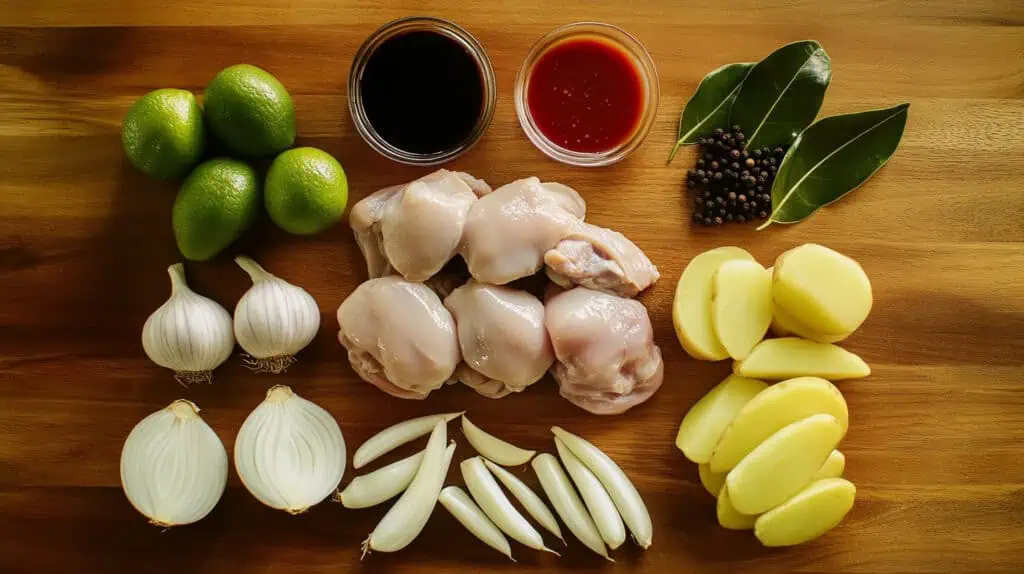
- 3 pounds chicken, cut into serving pieces
- ½ cup calamansi juice
- ¼ cup soy sauce
- 1 large onion, thinly sliced
- 4 cloves garlic, minced
- ½ teaspoon whole black peppercorns
- ¼ cup cooking oil
- 2 large potatoes, peeled and cut into ¼-inch slices
- 1 cup tomato sauce
- 1 cup water
- 2 bay leaves
- 2 tablespoons liver spread
- Salt to taste
Equipment Needed
- Large mixing bowl - For marinating the chicken thoroughly
- Heavy-bottom skillet or Dutch oven - Provides even heat distribution during braising, essential for tender meat
- Sharp knife - For cutting chicken into serving pieces cleanly
- Measuring cups and spoons - For accurate measurement of ingredients
- Tongs - For handling chicken safely without piercing the meat
- Wooden spoon - To stir and scrape fond without scratching your cookware
- Kitchen timer - To keep track of cooking and marination times
- Cutting board - For safe preparation of ingredients

How To Make
- Marinate the chicken: In a large mixing bowl, combine chicken pieces, calamansi juice, soy sauce, thinly sliced onion, minced garlic, and whole black peppercorns. Gently massage the marinade into the meat. Let marinate for 30 minutes at room temperature or up to 4 hours in the refrigerator.
- Fry the potatoes: Heat cooking oil in a large skillet over medium heat (180°C/350°F). Fry the potato slices until golden brown, about 3-4 minutes per side. Remove and set aside on paper towels, leaving 2 tablespoons of oil in the pan.
- Brown the chicken: Increase heat to medium-high (190°C/375°F). Brown the marinated chicken pieces for 3-4 minutes per side. Add the reserved marinade with onions and garlic, bringing to a boil for 2-3 minutes.
- Simmer: Add tomato sauce, water, and bay leaves. Reduce heat to low (150°C/300°F), cover, and simmer for 35-40 minutes or until chicken is tender.
- Finish the sauce: Stir in liver spread until well combined. Season with salt to taste. Arrange the fried potatoes around the chicken and simmer for an additional 2-3 minutes until the sauce thickens.
- Serve: Serve hot with steamed rice. For authentic Kapampangan presentation, garnish with additional spring onions if desired.

Tips from Lola's Kitchen
- Use native chicken for more authentic and intense flavor
- Don't skip the liver spread – it's truly the secret to the rich, velvety sauce
- Let the chicken marinate at room temperature for 30 minutes before cooking to ensure even flavor penetration
- Brown the chicken thoroughly – those caramelized bits create incredible depth of flavor
- Skim off excess oil as it cooks for a cleaner-tasting sauce
- Adjust the sauce consistency according to your preference – some families prefer it thicker, others more soupy
- Give it time to rest for 5-10 minutes before serving to allow flavors to settle
- Always taste before final seasoning as soy sauce saltiness can vary by brand
Substitutions
- Calamansi juice: Lemon juice or lime juice (1:1 ratio)
- Liver spread: Mashed chicken liver or liver pâté
- Tomato sauce: Fresh tomatoes (4 medium) + 2 tablespoons tomato paste
- Chicken parts: Chicken thighs can replace whole chicken parts for more uniform cooking
- Potatoes: Sweet potatoes (kamote) can replace regular potatoes for a unique twist
- Flavor enhancer: Apple cider vinegar (2 tbsp) can enhance tanginess if calamansi is less sour
Troubleshooting
Sauce Too Thin
- Simmer uncovered for 5-10 minutes longer to reduce
- Add 1 additional tablespoon of liver spread
- Mix 1 teaspoon cornstarch with 1 tablespoon cold water and stir in
Chicken Not Tender
- Continue cooking on low heat for 10-15 minutes
- Add ¼ cup hot water if needed to prevent drying out
- Ensure heat isn't too high during braising - gentle bubbles are ideal
Sauce Too Sour
- Add ½ teaspoon sugar to balance acidity
- Add more liver spread (1-2 additional teaspoons)
- Include extra tomato sauce (2-3 tablespoons)
Sauce Too Salty
- Add a quartered small potato to absorb excess salt while simmering
- Increase volume with 2-3 tablespoons more tomato sauce and a touch of water
- Add a small splash of calamansi juice to balance with acidity
Storage & Reheating
Storage:
- Refrigerator: 3-4 days in airtight container
- Freezer: Up to 3 months (without potatoes)
- Cool completely before storing to prevent condensation
- Store sauce separately from potatoes for best texture retention
Reheating:
- Stovetop: Medium heat with 2-3 tablespoons water (10 mins), stirring occasionally
- Microwave: 2-3 minute intervals at 70% power, stirring between
- Oven: 350°F (175°C) for 15-20 minutes in covered oven-safe dish
- Add fresh potatoes when reheating frozen asado for better texture
- Allow frozen asado to thaw overnight in refrigerator before reheating
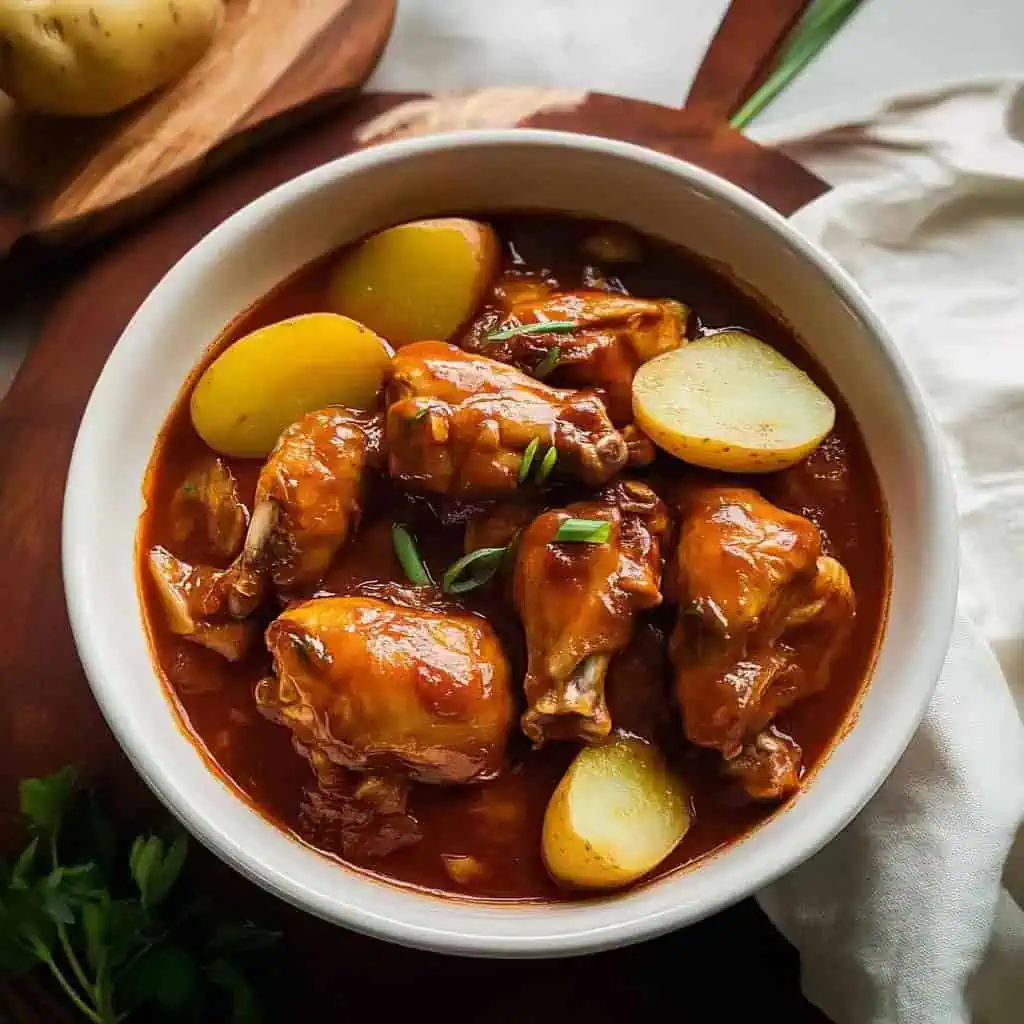
FAQ
Why does traditional asado use liver spread?
Liver spread adds richness, helps thicken the sauce, and provides a deeper umami flavor characteristic of Kapampangan cooking. It's the signature ingredient that distinguishes authentic Kapampangan asado.
Can I make this ahead for a party?
Yes! It actually tastes better the next day as flavors meld. Store separately from potatoes and reheat gently. Make fresh potatoes just before serving for best texture.
How spicy is this dish?
Traditional Chicken Asado isn't spicy at all, but you can add bird's eye chilies (siling labuyo) to taste if you prefer some heat.
Can I use bone-in chicken?
Yes, bone-in pieces add more flavor but may need 10-15 minutes extra cooking time. Check for doneness by ensuring meat pulls easily from the bone.
Is this dish good for meal prep?
Absolutely! The flavors actually improve over 1-2 days. Portion into containers with rice for quick meals, but store the fried potatoes separately to maintain their texture.
Can I make this in a slow cooker or pressure cooker?
Yes! For slow cooker, follow steps 1-3, then transfer to slow cooker and cook on low for 4-5 hours. For pressure cooker, reduce water to ¾ cup and cook under pressure for 12 minutes with natural release.
What's the difference between Kapampangan Asado and regular Filipino Asado?
Kapampangan Asado is distinguished by its tangy profile from calamansi, the essential liver spread that creates its signature richness, and the fried potatoes that absorb the flavorful sauce.
Related
Looking for other recipes like this? Try these:
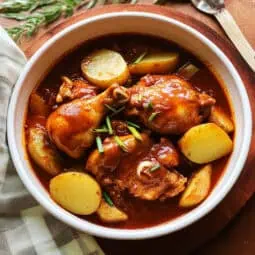
Kapampangan Chicken Asado (Asadong Manok)
Equipment
- Large mixing bowl Para sa pagma-marinade/for marinating
- Heavy-bottom skillet or Dutch oven (kaldero o kawali/heavy pan) For even heat distribution during braising
- Sharp Knife (Matatalas na Kutsilyo) For cutting chicken
- Measuring cups and spoons (Panukat) For accurate measurement
- Tongs [Sipit] For handling chicken safely
- Wooden spoon (sandok na kahoy) To avoid scratching your pan
- Kitchen Timer
- Cutting board (Sangkalan)
Ingredients
For the Marinade:
- 3 pounds chicken manok, cut into serving pieces
- ½ cup calamansi juice katas ng kalamansi
- ¼ cup soy sauce toyo
- 1 large onion sibuyas, thinly sliced
- 4 cloves garlic bawang, minced
- ½ teaspoon whole black peppercorns paminta
For Cooking:
- ¼ cup cooking oil
- 2 large potatoes patatas, peeled and cut into ¼-inch slices
- 1 cup tomato sauce
- 1 cup water tubig
- 2 bay leaves dahon ng laurel
- 2 tablespoons liver spread
- Salt asin to taste
Instructions
- Begin with the marinade (pagmamarinade): In a large mixing bowl, combine 3 pounds chicken pieces (manok), ½ cup calamansi juice, ¼ cup soy sauce (toyo), 1 thinly sliced large onion (sibuyas), 4 minced garlic cloves (bawang), and ½ teaspoon whole black peppercorns (paminta). Gently massage the marinade into the meat. Let marinate for 30 minutes at room temperature or up to 4 hours in the refrigerator.
- Heat ¼ cup cooking oil in a large skillet over medium heat (180°C/350°F). Fry the potato slices (patatas) until golden brown, about 3-4 minutes per side. Remove and set aside on paper towels, leaving 2 tablespoons of oil in the pan.
- Increase heat to medium-high (190°C/375°F). Brown the marinated chicken pieces for 3-4 minutes per side. Add the reserved marinade with onions and garlic, bringing to a boil for 2-3 minutes.
- Add 1 cup tomato sauce, 1 cup water (tubig), and 2 bay leaves (dahon ng laurel). Reduce heat to low (150°C/300°F), cover, and simmer for 35-40 minutes or until chicken is tender (malambot na ang manok).
- Stir in 2 tablespoons liver spread until well combined. Season with salt (asin) to taste. Arrange the fried potatoes around the chicken and simmer for an additional 2-3 minutes until the sauce thickens (hanggang lumapot ang sarsa).
- Serve hot (ihain habang mainit pa) with steamed rice (kanin). For authentic Kapampangan presentation, garnish with additional spring onions (dahon ng sibuyas) if desired.
Tips from Lola's Kitchen
- Choose native chicken (native na manok) for more flavor
- Don't skip the liver spread – it's the secret to rich sauce
- Let the chicken marinate at room temperature for 30 minutes before cooking
- Brown the chicken well for better flavor
- Skim off excess oil as it cooks for a cleaner-tasting sauce
Nutrition
The Story Behind Kapampangan Chicken Asado (Asadong Manok)
While many Filipino dishes trace their roots to Spanish colonial times, Kapampangan Chicken Asado tells a unique culinary story. Though its name derives from the Spanish word "asar" (meaning to grill), this dish evolved far from its namesake to become something distinctly Filipino, particularly in Pampanga, the country's culinary capital.
In Pampanga's vibrant food scene, two versions of asado emerged over time. The first, influenced by Chinese traders, features sweet-salty notes and warm spices like star anise. However, it's the native Kapampangan version, known as "asado de carajay," that has become a household staple. This version showcases the region's masterful balance of sour and savory flavors, using local calamansi instead of imported citrus.
What sets Kapampangan Chicken Asado apart is its ingenious use of liver spread – a post-World War II addition that transformed the dish. This ingredient, which became widely available during the American period, adds a rich depth that's now considered essential to authentic Kapampangan asado. Unlike other tomato-based Filipino dishes like menudo or mechado, asado's signature tangy-savory sauce has a distinct consistency and flavor profile that comes from this clever incorporation of liver spread.
Today, this dish represents how Kapampangan cooking often elevates simple ingredients through technique and timing. The careful sequencing of marinating, browning, and braising creates layers of flavor that have made this dish a favorite at family gatherings and fiestas. While every Kapampangan household may have its own version, the core elements of calamansi, tomato sauce, and liver spread remain consistent, proving how some culinary innovations become beloved traditions.
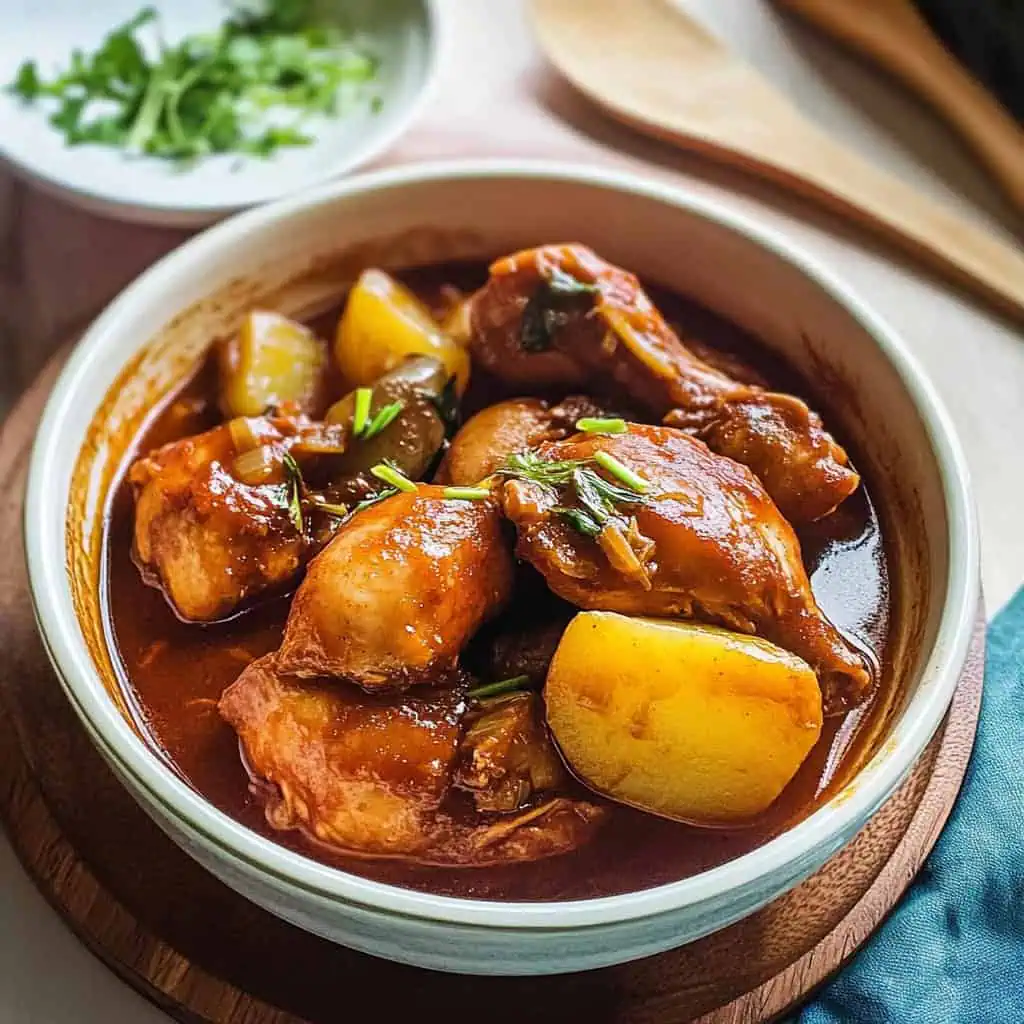









Comments
No Comments